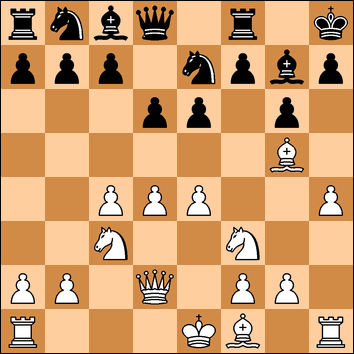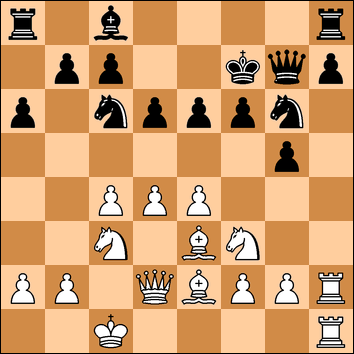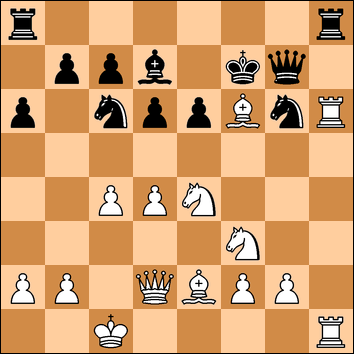Thursday 31 March 2016
White: K. Nevols (132) - Black: B. Sawyer (87)
Having now secured my place in the top group, I needed to get a draw from my final game to finish the first round in third place.
1. e4 g6
2. d4 Bg7
2. .. Nf6 would take us into the Pirc. Now I decide to take us into the Kings Indian defence, an opening I know much better (although usually as Black).
3. c4 d6
4. Nc3 e6
I think I'd prefer 4. e5.
5. Nf3 Ne7
An unusual placement for the knight. The usual thoughts in this opening have to be slightly adjusted by the fact the bishop on g7 is now not blocked by the knight which usually sits on f6. I made a mental note to keep an eye out for tactics revolving around c5, Qb6 and any attacks on the b2 square.
6. Bg5
With the intention to cause a weakness around the kingside. If now 6. .. h6 my plan was to play 7. Be3.
6. ... O-O
7. Qd2
And now h6 cannot be played.
7. ... Kh8?!
A surprise. I had expected c5, Nc6 or Na6. I can only guess the plan is to play the knight to g8 and then h6 but this is too slow. The knight is still pinned at the moment.
8. h4!

I decide to punish the last move and go straight on to the attack. I was in two minds here. Part of me was saying I ought to play it safe and play Be2 and castle, while the other said go for it. I analysed both 8. .. e5 to which I planned 9. d5 closing down the centre, and 8. .. h5 to which I thought about 9. Be2 with possibly Nh2 and g4, or 9. Bh6. I also saw Black's next move and gave some thought to a piece sacrifice.
8. ... f6
The move I gave a lot of thought to was 9. h5?! - inspired by a Kasparov game many years ago. However I decided against it for three reasons - firstly, I am not Kasparov (!), secondly, there is no need to take risks at his early stage when I am (allegedly) the stronger player and, thirdly, I was not sure if it would work. 9. .. fxg5 10. hxg6 Nxg6 11. Nxg5 h6 was as far as I got. Instead I stuck to the more sensible move.
9. Be3 Qe8
This defends against h5 but leaves the c7 pawn open. However, 10. Nb5 does nothing against 10 .. Na6 and then 11. .. c6 would show the whole idea is a waste of time.
9. .. e5 would have been better to meet 10. d5 with 10. .. Bg4 and 10. h5 gxh5 11. Rxh5 again with 11. ... Bg4. (10. dxe5 dxe5 11. Qxd8 Rxd8 and White keeps an edge in development but no danger yet).
10. Be2 Nbc6?
But this gives me the chance to now deflect the queen and get h5 in.
Computers usually like pawn pinching and this one is no exception - recommending 11. d5 Ne5 12. Nb5 Qd8 13. Nxa7. I didn't see this but I am not sure I would have gone for it - it would give Black time to play for plans involving a counterattack in the centre around f5.
11. Nb5 Qd7
Now the above sequence is improved by the blocking of the bishop. 12. d5 Ne5 13. Nxe5 fxe5 14. Nxa7 and Nxc8 to come.
12. h5 g5?
Black sacrifices a piece!! I had looked at 12. .. gxh5 13. Rxh5 planning to castle queenside and double up on the h-file.
13. h6 Ng6
14. hxg7+ Qxg7
15. O-O-O
So now I am a piece for a pawn up. The next job is to double the rooks on the h-file.
15. ... a6
16. Nc3 Kg8
Preparing to defend the h-pawn. The other option I had looked at was 16. ... Rg8 17. Rh2 Nf8.
Now I could not decide between Rh2 and Rh5. The former looked wimpy - one gets a sense of manliness when one shoves the pieces into the opponent's face! - but after Black had played Kf7 and Rh8 I knew there might be a chance of Bd7-e8 which would get a tempo. Also, on h2, the g2 pawn is defended - which might be useful.
17. Rh2 Kf7
18. Rdh1 Rh8
OK, where next? My eye went to the g5 pawn. If I could undermine it and somehow get the knight or bishop there I would further increase my advantage.

19. e5!
The variation I looked at first ran basically like this. 19. ... dxe5 20. dxe5 Ncxe5 21. Bxg5? fxg5 22. Rxh7 Rxh7 23. Rxh7 Qxh7 24. Nxg5+ Kg7 25. Nxh7 Kxh7. That would leave my with a queen and a pawn for a rook and a knight. But I decided against that as it was giving up too much material just to get the queen. Remember - I am already a piece for a pawn up.
And then I saw the beautiful - 21. Nxe5+ Nxe5 22. Bh5+ Ke7?? 23. Bc5 checkmate! So Black would have to play 22. .. Ng6. I pondered about 23. Ne4 and also 23. Bxg6+ Kxg6 24. Qd3+ (24. .. f5 25. Bd4 e5 doesn't go very far) but then decided this was all too far into the future, I must have got something wrong somewhere, and my head was hurting.
So I decided to play e5 anyway on instinct - the worst that could happen was losing a second pawn for the piece I was up.
19. ... h6
Instead Black decides to protect the g-pawn resulting in the following sequence.
20. exf6 Kxf6
21. Ne4+ Ke7
22. Rxh6
So that 22. .. Rxh6 23. Rxh6 Qxh6 24. Bg5+ or 23. Bg5+.
22. .... Bd7
23. Bxg5+ Kf7
24. Bf6!

I was pleased to find this move which opens the diagonal for the queen to join in. The end is nigh!
24. ... Rxh6
25. Rxh6 Qg8
26. Nfg5+ Ke8
If 26. ... Kf8 then 27. Nh7+ with Bh5 next.
27. Bh5 Nce7
28. Rh8 Resigns
A nice touch to finish off - pinning two Black pieces.
No comments:
Post a Comment